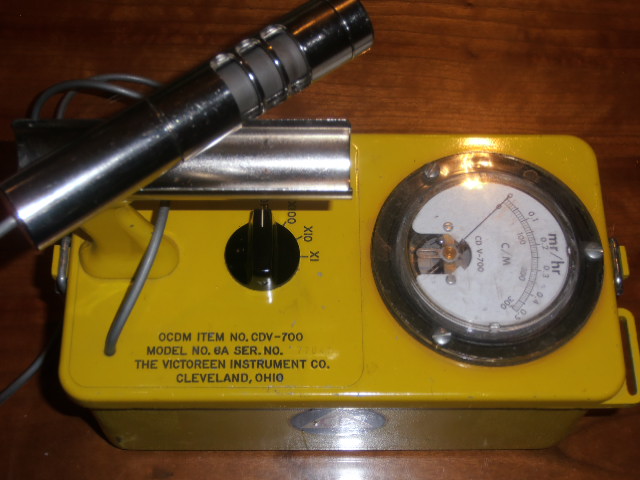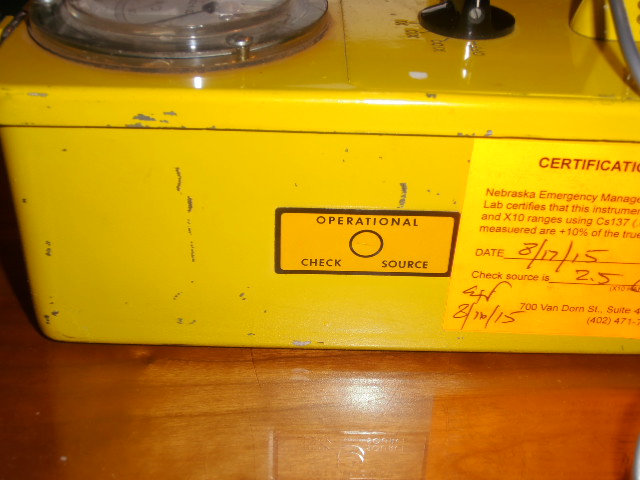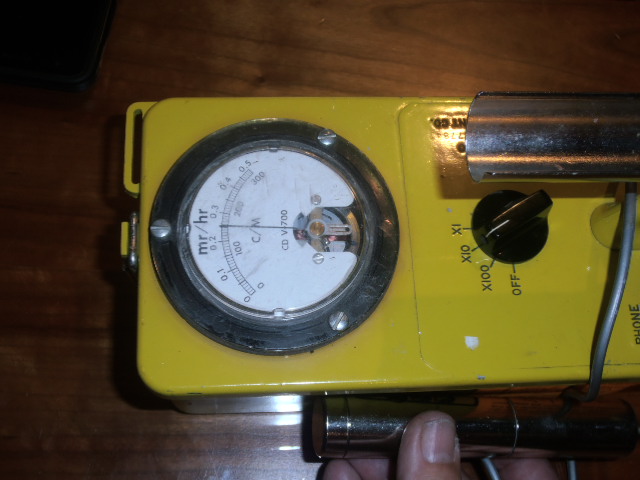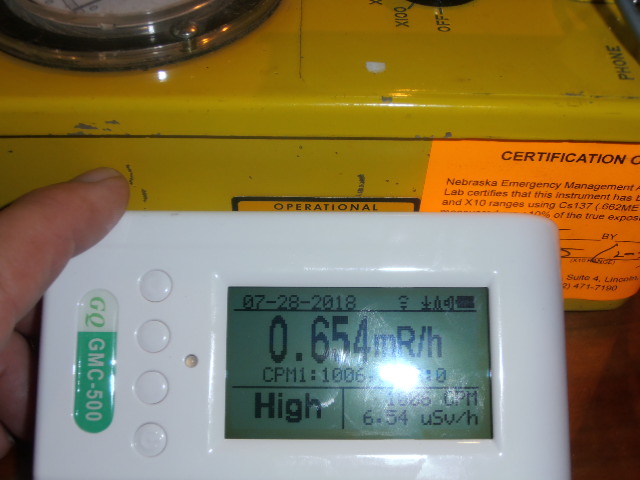| T O P I C R E V I E W |
| Stargazer 40 |
Posted - 07/27/2018 : 05:20:33
Yesterday I received the second surplus Civil Defense meter I wanted to compare and contrast with the GQ 500+. This one is a CD-V 700 high sensitivity meter with a 6993 GM tube. Before I do actual comparisons I wanted to check the calibration of the new meter. This meter has a Cs137 check/calibration source on the side of the case. The tube holder/wand has a sliding shield that allows beta to get to the tube and can be closed for primarily gamma readings. Calibration is straight forward; with the shield open tube placed centered on the source, the meter should read 2.0 mR (roughly 1250 CPM of the 6993 GM tube) in the 10X switch position. Adjustment is made with pot inside case . The problem I see is that the meter is high serial number 6A (~78000) and likely produced late in the manufacturing cycle (1961-1974), and the Cs137 source is likely diminished in activity significantly. Currently the meter shows 2.5 mR when I put the wand over the source, which is higher than the manual states it should read when calibrated, but I think it is calibrated according to manual procedure. I don't think it's taking into account the diminished source.
Using tube 1 setting of the 500+ I measured CPM of the calibration source of the 700, getting 1100 CPM. That gives .715 mR; a far cry from the 2.0 mR necessary to properly calibrate the instrument. My gut says to detune the meter to the .715 mR reading on the 10X scale and it will be calibrated with this source properly. Does that make sense?
Half life calculations for Cs137 show if this source started at 2.0 mR strength for this meter, then counts indicated by the 500+ show 45 years of diminishment. I get manufacture date of 1973.
Thanks for commenting on this approach. Coming back up to speed with stuff I haven't played with for many years.  |
| 18 L A T E S T R E P L I E S (Newest First) |
| Stargazer 40 |
Posted - 08/31/2018 : 06:57:34
Thanks for explaining that. Note first that the 700's GM tube will act no different really in lowering the voltage as counts increase. For me that says that even though this is a fifty year old device the likelihood that just about any of these commercial meters has a PS that can even get close to counts associated with saturation before voltage falls below plateau levels is getting higher and higher. I contacted Mazur which makes a $600 meter with pancake detector. From ZLM's comment concerning more efficient energy draw and less current we might assume that there is value to the 600+ in reaching much broader useful count range with similar detector. Mazur hasn't returned my call, and I did explain that I was interested in PS voltage regulation. We'll see.
I think sellers really take liability seriously and stating that the 700 has high voltage PS and urges caution does mitigate that in their minds. It caused me to be much more careful. Nice to know that he two alkaline D batteries likely can't be rigged to electrocute somebody. |
| ullix |
Posted - 08/31/2018 : 02:17:38
I took your data from this post on the CD_V 700, and your GMC-500+ data from Reply#75 here http://www.gqelectronicsllc.com/forum/topic.asp?TOPIC_ID=5369 and estimated the internal resistance of the HV gen according to this discussion Reply #15 http://www.gqelectronicsllc.com/forum/topic.asp?TOPIC_ID=5369
I get with your data:
Device Internal Resistance [MOhm]
CD-V 700 8.4
GMC-500+ 15.4
The 15.4 is close enough to the 16.12 I had determined earlier, so, it is a confirmation. Let's call it 16MOhm. The CD-V 700 with 8Mohm is clearly more powerful. The RadMon+ had come out at about 12MOhm in other measurements.
But even the CD-V 700 does not create a lethal voltage by any means: when you shortcut its 900V, the internal resistance allows a current of ~110µA. Including skin resistance (when touching) it is somewhat less.
The "Threshold of sensation" is 1000µA (https://www.physics.ohio-state.edu/~p616/safety/fatal_current.html ) and Wikipedia (https://en.wikipedia.org/wiki/Electrical_injury ) has it at 500µA, though state "perceptible but no muscle reaction" for up to 5000µA.
This is confirmed by a German Technical report based on official DIN standards (DIN IEC/TS 60479-1 (VDE V 0140-479-1), norms, www.loullingen.lu/projekte/Defibrillator/103-STRO2.pdf) which gives an ever higher limit for DC of 2000µA.
No reason for concern.
|
| Stargazer 40 |
Posted - 08/29/2018 : 05:23:32
With the 1Gohm probe the voltage is 896VDC (the 990Mohm resistor makes it easy to add two zeros to the measure and get voltage direct without resorting to ZLM's formula). With just the 10Mohm meter on 1000VDC scale the voltage is 467VDC |
| ullix |
Posted - 08/29/2018 : 01:45:45
@stargazer: now that you have a high-Ohm resistor, I wonder if you can do some tests on your CD-V 700 counter.
In its maximum range it supports CPM=30 000. According to them this is 50mR/h = 500µSv/h. This implies a tube calibration factor of 0.017 µSv/h/CPM, or 2.6 times less sensitive than a M4011. They were diligently enough to describe their source as "radium-equivalent radiation".
But with "only" CPM=30000 to support, the device does not need a more powerful HV than e.g. a GMC counter!
I took a good look into its manual. The HV is generated by the same principle as in the modern counters also, albeit with a chopping at different frequencies: CD-V700: ~100Hz, Radmon: 2.5kHz, GMC: varying 2.5...4.5kHz. This makes the latter two more efficient (and allows smaller build), but the inductance used could be making all the difference re HV power.
The pulsed HV is rectified and smoothed via standard RC components. The capacitors C4 and C5 are only 1nF and 10nF, resp. That is the same or even 10fold LOWER than in the RadMon, and only 10% higher than in a GMC! There is not much charge anyway that can be stored in such small capacitors! The voltage is limited by a tiny glow lamp to a max around 900V.
Of interest is the description on how to measure the HV: an electrostatic voltmeter is recommended. This is a rare instrument, which has the advantage of not drawing any current. I've never seen such an instrument in my life! It should read, quote: "910+/-10V". It is continued, quote: "This voltage may also be measured with a 20,000 ohms-per-volt meter on the 5,000 volt range"
Such an instrument at 1000V would have 20000 Ohm/V * 1000V = 20MOhm, and draw 50µA. And still measure 910V ??? That would really be a powerful HV generator; very strange when you first ask for an electrostatic voltmeter.
At the current of 0.095µA per 1000CPM, which I had determined, 50µA would support an M4011 tube up to CPS=8800, i.e. more than twice as much as the tube could handle!
So, I suggest two measurements:
1) measure Anode vs GND via your 100x probe on a 10 MOhm DVM (or oscilloscope)
2) measure Anode vs GND directly (without 100x probe) on a 10 MOhm DVM (or oscilloscope) in its 1000V range setting.
No need for counts, though if you have a good source, repeat measure 1).
|
| ullix |
Posted - 08/08/2018 : 07:34:46
Look into Potty Training for KCl dose rates. CPM~150, with sandwich up to ~twice as much. Including bakcground. Depends on exact sandwiching geometry, and perhaps salt due to e.g. granularity and therefore packing density
As your data seem to be a bit on the low side, I suppose you measured with the backside of the counter still mounted? The case is already holding back quite a few of the betas. Thus you have largely, but not exclusively, measured gammas. I suppose the wand has sufficient steel wall to hold back all betas, but the 500 will give you a mix; not quite comparable.
See Potty training for absorbers needed to absorb all beta. What does the 700 report with its window open and fully exposed to the K40?
|
| Stargazer 40 |
Posted - 08/07/2018 : 17:49:10
Didn't take into account background. I'll relook. |
| Stargazer 40 |
Posted - 08/07/2018 : 17:46:34
Got my KCl in. Made two 1 lb. bags. Immersed wand of 700 in between. On X1 scale read .15mR/h. Immersed 500+ in between the two bags. Read .048mR/H. Pretty much as expected as the 700 miscalibrated by a factor of three times in my opinion (due to half life decay of the built in source (Cs137). I may play with the calibration to bring it in line. Was not surprised that the KCl was that radioactive, but does that fit activity you were expecting? |
| ullix |
Posted - 07/29/2018 : 00:27:40
quote:
The calibration sticker only says it was calibrated to 2.5 on the 10x scale.
That speaks of a breathtaking ignorance of these calibration people. How can you possibly "calibrate" something to the original value when the original value has lost 2/3rd of its intensity? Hilarious!
I wouldn't touch the CAL knob for now; just keep in mind that the reading is 2.5 / (2.5 * 37%) = 2.7fold too high.
But don't try to make any sense out of some other instrument reading a value which surfaced somewhere along the discussion.
Yes, go Potty with that bucket of salt!
|
| Stargazer 40 |
Posted - 07/28/2018 : 12:16:50
quote:
Originally posted by ullix
How close am I?
I need to buy some KCl. 
Amazon US has 5 lb (~2 Kg?) for $17.99 USD |
| Stargazer 40 |
Posted - 07/28/2018 : 10:09:18
I didn't adjust the meter at all (yet). It is the way it came.
GMC500+ shows .7 mR/h when held next to the Cs source on the case. I think your numbers are correct and that's what the 500+ shows for original source. I think the meter is incorrectly calibrated with the original source and made higher than the 2.0 mR/h it should be to compensate for later time further decay. Can't say whether deliberate or simply uneducated on half life effects of the 45 year old Cs.
The calibration sticker only says it was calibrated to 2.5 on the 10x scale. Now I question whether it is talking about the source at all. Likely that's what they set it to, but I still think they used the original source that was only 35% of what it once was so incorrect. |
| ullix |
Posted - 07/28/2018 : 08:04:46
I just noticed that one pictures shows a reading of 0.25 "mr/hr" at a 10x setting, so 2.5mR/hr, just as much as it should show when puchased.
This is unexpectedly high. Did you make any adjustments at the "CAL" potentiometer? Was the radioactive source refreshed in 2015? |
| ullix |
Posted - 07/28/2018 : 07:56:42
Ok, one of these "flat iron" types, as I like to call them.
And it comes with "a radioactive sample ... mounted on the side of the case" - gasp! - those were the good old days...
So with Cs137 in there and a certificate issued as recently as 2015 - unfortunately your photos cut off the further text on the certificate. Does it give a number of what the absolute or relative dose was in 2015? It should have been 37.2% of original, as opposed to 35.6% today. No big difference.
But unfortunately it is difficult to impossible to compare those readings with today's GMC counters.
Today's standardized Cs samples set you back 800€ in Europe, and only after you have obtained a license to acquire such samples! Those are packaged in a metal housing such than no betas can escape, hence a pure gamma source.
However, in this classic counter it is the betas, they want to use as reference. Easy to understand as a Geiger tube has an efficiency near 100% for betas, but at best in the single digit % for gamma (the SI3BG tube surely well below that low end).
In order to do a calibration, according to their manual, you must open a sliding window at the site of the tube, and hold this to this Cs-source patch at the side of the counter. Originally the instrument should show "2 mr/hr", so today one would expect a reading of 2*36% = ~0.7 "mr/hr".
This does NOT mean that the source delivers this does rate! It means this is what you read on the display, when you make this test. The instrument is intended for measuring gamma radiation, and only for gamma will it give meaningful answers. It is only a procedure, which they (supposedly) have verified in their labs to demonstrate that an instrument calibrated in this way, will later give proper readings when applied in a gamma environment!
The sliding window is probably of a thickness of 0.5mm. From the data in Potty Training you can determine that 0.3mm steel is sufficient to keep all Cs-137 betas away. Gammas, including those from Cs-137, are weakened by something well below 1%.
The instrument scale shows that 300CPM equal "0.5 mr/hr", which is 5µSv/h. Divide 5 by 300 and you get 0.017 µSv/h/CPM, or 3x less sensitive than the M4011, as it is currently assumed.
On page 7 of their manual they state a typical background of 20CPM. As this is in the same range as what the GMC counters deliver, it looks like an approximately 3fold higher background than with a GMC counter. Should still allow some Pottyassium experiments, like this:
Have 2 plastic bags of KCl (or K2CO3, basically the same effect) ready, with a pound of this salt in each. Establish the background of each instrument in its most sensitive setting.
Next put one bag below and one above the probe or the GMC counter, resp., so that the tube/instrument is basically wrapped in K-Salt. Wait for a stable reading, record with GeigerLog if you can.
The results on both instruments should be almost only due to gamma. I expect a reading of near 60CPM on the GMC. For the CDV700 I'd take the background of 20 + 1/3 of 60, gives a reading of 40. How close am I?
Note: When you have a big bag of K-salts, the betas from the bottom layer won't reach the surface. So for measuring betas a thin bag (1cm?) may be enough. But gammas are mostly undisturbed by the salt, and fly through. Thus for measuring gammas you benefit from a thick bag. Therefore at least 1 pound per bag.
I got good results from this amazon Germany stuff: https://www.amazon.de/Kaliumchlorid-Di%C3%A4tsalz-1kg-KCl-chem/dp/B00IAJEYBY/ref=sr_1_1?ie=UTF8&qid=1532792543&sr=8-1&keywords=kcl
Next experiment: slide open the window, and open the back of the GMC counter. Put the window and the tube, resp, as close as possible to the K-salt. Wrapping not necessary. I expect ~150 for the GCM counter, no idea for the flat iron.
|
| Stargazer 40 |
Posted - 07/28/2018 : 05:02:49
Here is the meter:
Image Insert:

80064 bytes
Here is the calibration source affixed to side of lower part of meter case:
Image Insert:

79151 bytes
Here is the wand with beta shield open held against the source and meter reading mR:
Image Insert:

79627 bytes
Here is GMC 500+ with tube 1 held against source showing 1000 CPM (held better it's 1100 CPM).
Image Insert:

78243 bytes
The manual describing the calibration procedure is here:
h**p://www.clarisonus.com/Archives/Radiology/VictoreenCDV700.pdf
Calibration is page 7.
Yes it's Cs 137.
Note that the calibration sticker clearly shows the check source is 2.5 mR. Date of calibration is Aug 2015. The expiration is three years out so the exp date shown lower left on label is actually 2018. The calibration should still be valid. However it is not reading an independent source, but the source on the side of the case so mis-calibrated. |
| ullix |
Posted - 07/28/2018 : 00:55:13
@stargazer40: interesting device; I like those old clunkers ;-) and the careful thoughts that went into their design.
I am not familiar with it, and couldn't quite follow your description. Could you add some photos, in particular on how this Cs source is added to the system for calibration? Is there a manual to document the calibration procedure? Please, publish if so.
Cs137 (it is certain that it is Cs137?) has a half life of 30.17 years, so after exactly 45 years there should still be 35.6% of the original strength left. If 100% had worked, then a bit more than a third will also work; just account for the 36%.
|
| EmfDev |
Posted - 07/27/2018 : 15:35:33
Maybe it will work. But need to test with other sources to see
if it actually works. |
| Stargazer 40 |
Posted - 07/27/2018 : 05:44:50
Great, thanks! |
| ikerrg |
Posted - 07/27/2018 : 05:29:06
You can actually edit the thread title. Use the little pen icon at the right of your thread in the main forum link (http://www.gqelectronicsllc.com/forum/forum.asp?FORUM_ID=14). |
| Stargazer 40 |
Posted - 07/27/2018 : 05:23:20
Perhaps GQ could edit title of thread to GMC instead of GMS. It would be nice to be able to edit these if even for just a short period (or to delete and start over). |
|
|

